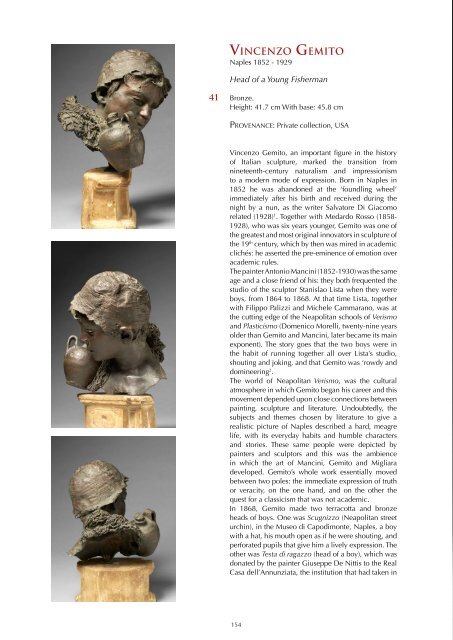You also want an ePaper? Increase the reach of your titles
YUMPU automatically turns print PDFs into web optimized ePapers that Google loves.
Vincenzo Gemito<br />
Naples 1852 - 1929<br />
Head of a Young Fisherman<br />
41<br />
Bronze.<br />
Height: 41.7 cm With base: 45.8 cm<br />
Provenance: Private collection, USA<br />
Vincenzo Gemito, an important figure in the history<br />
of Italian sculpture, marked the transition from<br />
nineteenth-century naturalism and impressionism<br />
to a modern mode of expression. Born in Naples in<br />
1852 he was abandoned at the ‘foundling wheel’<br />
immediately after his birth and received during the<br />
night by a nun, as the writer Salvatore Di Giacomo<br />
related (1928) 1 . Together with Medardo Rosso (1858-<br />
1928), who was six years younger, Gemito was one of<br />
the greatest and most original innovators in sculpture of<br />
the 19 th century, which by then was mired in academic<br />
clichés: he asserted the pre-eminence of emotion over<br />
academic rules.<br />
The painter Antonio Mancini (1852-1930) was the same<br />
age and a close friend of his: they both frequented the<br />
studio of the sculptor Stanislao Lista when they were<br />
boys, from 1864 to 1868. At that time Lista, together<br />
with Filippo Palizzi and Michele Cammarano, was at<br />
the cutting edge of the Neapolitan schools of Verismo<br />
and Plasticismo (Domenico Morelli, twenty-nine years<br />
older than Gemito and Mancini, later became its main<br />
exponent). The story goes that the two boys were in<br />
the habit of running together all over Lista’s studio,<br />
shouting and joking, and that Gemito was ‘rowdy and<br />
domineering 2 .<br />
The world of Neapolitan Verismo, was the cultural<br />
atmosphere in which Gemito began his career and this<br />
movement depended upon close connections between<br />
painting, sculpture and literature. Undoubtedly, the<br />
subjects and themes chosen by literature to give a<br />
realistic picture of Naples described a hard, meagre<br />
life, with its everyday habits and humble characters<br />
and stories. These same people were depicted by<br />
painters and sculptors and this was the ambience<br />
in which the art of Mancini, Gemito and Migliara<br />
developed. Gemito’s whole work essentially moved<br />
between two poles: the immediate expression of truth<br />
or veracity, on the one hand, and on the other the<br />
quest for a classicism that was not academic.<br />
In 1868, Gemito made two terracotta and bronze<br />
heads of boys. One was Scugnizzo (Neapolitan street<br />
urchin), in the Museo di Capodimonte, Naples, a boy<br />
with a hat, his mouth open as if he were shouting, and<br />
perforated pupils that give him a lively expression. The<br />
other was Testa di ragazzo (head of a boy), which was<br />
donated by the painter Giuseppe De Nittis to the Real<br />
Casa dell’Annunziata, the institution that had taken in<br />
154
















